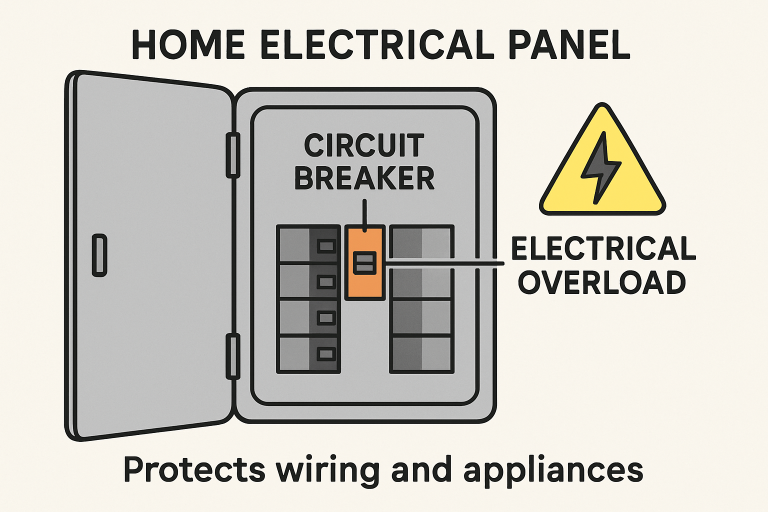Table of Contents
Key Takeaways
- Circuit breakers protect homes and businesses by interrupting electrical flow during overloads or short circuits, preventing fires and damage.
- They use thermal, magnetic, or hybrid mechanisms to detect unsafe currents and shut off power instantly.
- Common signs of faulty breakers include frequent tripping, burning smells, or visible damage.
- Proper resetting, maintenance, and timely replacement by licensed professionals ensure safety and compliance.
- Modern breakers enhance safety and efficiency with smart monitoring, real-time alerts, and improved fault detection.
What Does A Circuit Breaker Actually Do?
Modern homes and businesses rely on a seamless, safe supply of electricity; the key defender of that safety is the circuit breaker. As an essential safety device, a circuit breaker’s main function is to monitor the flow of electrical current through a circuit and instantly interrupt power if it detects an overload or short circuit, preventing potential disasters. This split-second reaction is crucial—without it, wiring or devices can overheat, causing electrical fires or damaging property. When these devices wear out or malfunction, timely repair or circuit breaker replacement tyler tx is not just advisable, it’s necessary for maintaining electrical safety. The basic mechanism inside a circuit breaker works by constantly measuring the flow of electricity. If the current exceeds a safe level because of a fault or overload, the breaker triggers a switch with a thermal or magnetic component to cut off power.
The Science Behind Circuit Breakers
Circuit breakers control the flow of electric current, which is measured in amperage and voltage. The circuit can overload when too many appliances draw power from a single source. In such cases, the heightened amperage can heat wires beyond safe temperatures, increasing the risk of melting insulation or igniting fires. A circuit breaker senses the abnormal current and disconnects the flow, ensuring hazardous conditions do not escalate. Fault detection relies on thermal (heat-activated) or magnetic (rapid current spike) triggers, while newer hybrid models combine both to offer enhanced speed and accuracy.
Why Every Home Needs Circuit Breakers
Circuit breakers serve as the backbone of residential electrical safety, offering protection against one of the leading causes of home fires: electrical malfunctions. According to the U.S. Fire Administration, tens of thousands of residential electrical fires occur annually, resulting in hundreds of injuries and millions of dollars in property damage. Everyday hazards like overloaded outlets—often caused by plugging too many devices into a single power strip—or malfunctioning household appliances are easily managed by operational circuit breakers, stopping a small issue from turning catastrophic.
Circuit Breakers In Modern Infrastructure
These indispensable devices aren’t exclusive to homes. Circuit breakers are scaled up in commercial and industrial environments to match larger power demands and increasing complexity. In all settings, they offer grid reliability by maintaining a stable, safe flow of electricity and reducing the chances of widespread power failures. The latest breakthroughs in circuit breaker design, such as digital controls and remote operation, further enhance their safety and efficiency. For instance, advanced monitoring can now alert building managers to potential hazards in real-time, minimizing downtime and improving response times.
Common Signs Of A Faulty Circuit Breaker
- Frequent tripping or a breaker that cannot be reset suggests it can no longer reliably detect and manage electrical loads.
- Burning or smoky smells from the breaker panel indicate overheating or arcing within the device.
- Visible signs of physical damage or corrosion on the panel or breakers, reflecting exposure to moisture, heat, or prolonged wear.

How To Safely Reset Or Replace A Circuit Breaker
Resetting a tripped breaker is usually straightforward: first, switch off all appliances or devices connected to the affected circuit. Next, locate the breaker panel and identify which breaker has moved to the “off” or neutral position. Firmly switch it all the way off, then back on. If it trips again immediately or won’t reset, do not keep attempting to reset it—this signals a deeper issue. While homeowners can reset breakers with caution, a licensed professional should always perform replacement or inspection to avoid personal injury and ensure that local electrical codes are met. Personal protective equipment, such as insulated gloves and safety goggles, is essential for anyone working near live electrical panels.
The Cost & Value Of Replacing Circuit Breakers
The average cost to inspect and replace a circuit breaker ranges from $150 to $300, depending on accessibility, panel type, and local labor rates. While it might seem unnecessary, the long-term value is substantial: operational breakers protect your home’s infrastructure, decrease insurance premiums, and maintain property value during resale. Homes with modern, code-compliant electrical systems are also more attractive to buyers and insurers, underscoring the financial wisdom of keeping your panel and breakers up to date.
The Future Of Circuit Breakers & Home Safety
Circuit breakers are adapting with the rise of smart home technology. Modern panels can connect with apps to deliver real-time updates, alert homeowners to tripped breakers, and provide energy usage statistics. Advances in sensor technology mean that future breakers will better distinguish between harmless surges and true electrical hazards, further reducing nuisance trips while increasing safety. As these systems become more advanced, maintaining an up-to-date electrical system is vital for safety and harnessing the benefits of connectivity and home automation.





No Comments